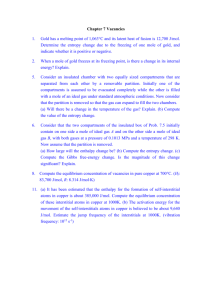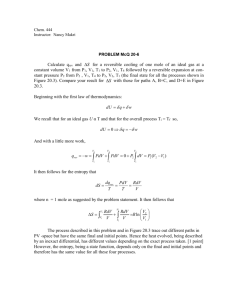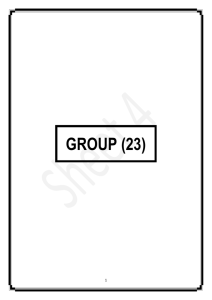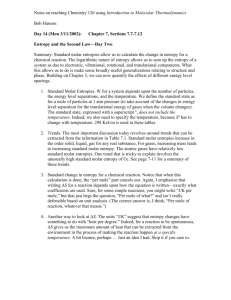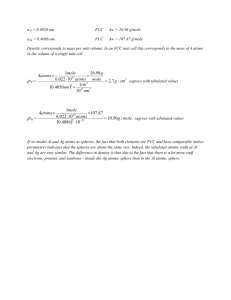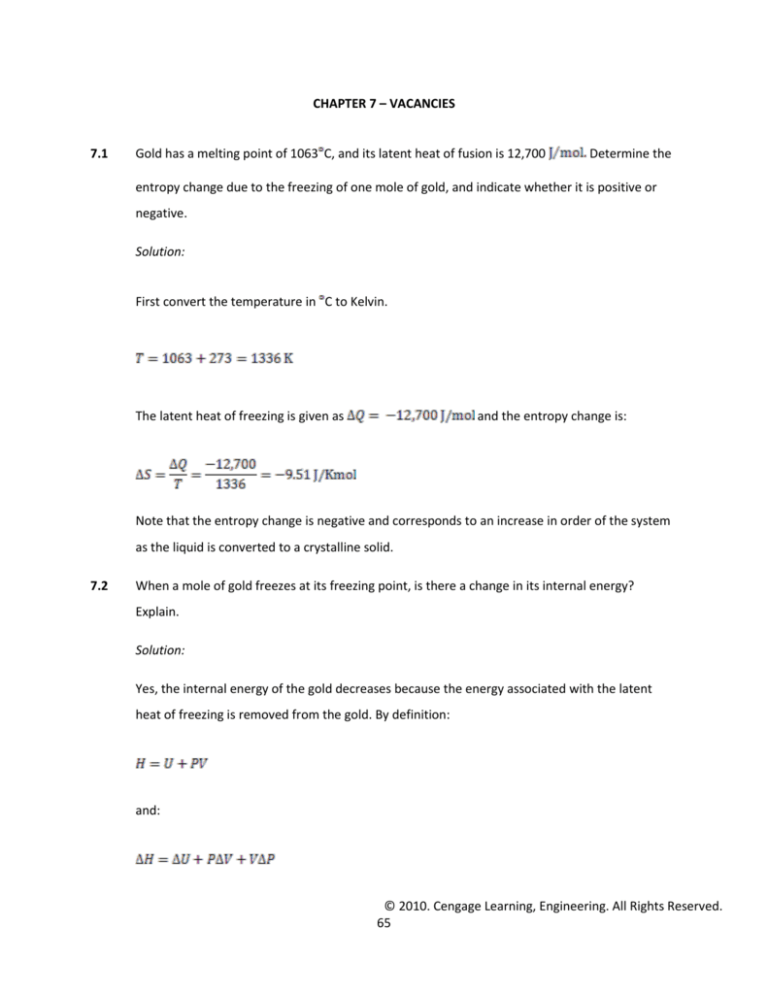
CHAPTER 7 – VACANCIES
7.1
Gold has a melting point of 1063 C, and its latent heat of fusion is 12,700
Determine the
entropy change due to the freezing of one mole of gold, and indicate whether it is positive or
negative.
Solution:
First convert the temperature in C to Kelvin.
The latent heat of freezing is given as
and the entropy change is:
Note that the entropy change is negative and corresponds to an increase in order of the system
as the liquid is converted to a crystalline solid.
7.2
When a mole of gold freezes at its freezing point, is there a change in its internal energy?
Explain.
Solution:
Yes, the internal energy of the gold decreases because the energy associated with the latent
heat of freezing is removed from the gold. By definition:
and:
© 2010. Cengage Learning, Engineering. All Rights Reserved.
65
However, under normal conditions during freezing, the pressure is constant so that
the volume change is small so that we may assume
7.5
and
Thus
Consider an insulated chamber with two equally sized compartments which are separated from
each other by a removable partition. Initially one of the compartments is assumed to be
evacuated completely, while the other is filled with a mole of an ideal gas under standard
atmospheric conditions. Now consider that the partition is removed so that the gas can expand
to fill the two chambers.
(a) Will there be a change in the temperature of the gas? Explain.
(b) Compute the entropy change.
(c) Compute the Gibbs free-energy change. Is the magnitude of this change significant? Explain.
Solution:
(a) This problem involves changes in the internal energy.
Where
is the work done on, or by, the system which in this case equals zero; that is
. At the same time by the condition of the problem heat is neither added too, nor taken
out of the system so that
(b)
. As a result
and
is positive because the reaction is irreversible.
(c) In order to evaluate
, consider that the gas is returned reversibly to its original state. In this
process:
© 2010. Cengage Learning, Engineering. All Rights Reserved.
66
where P is the pressure, and V the volume of the system. In an ideal gas,
.
Therefore,
where
, Thus,
and
7.6
Consider that the compartments of the insulated box of Prob. 7.5 initially contain on one side a
mole of ideal gas A and on the other side a mole of ideal gas B, with both gases at a pressure of
0.1013 MPa and a temperature of 298 K. Now assume that the partition is removed.
(a) How large will the enthalpy change be?
(b) Compute the entropy change.
(c) Compute the Gibbs free-energy change. Is the magnitude of this change significant? Explain.
Solution:
(a) This problem involves the mixing of two ideal gases, and thus invloves an entropy of mixing:
© 2010. Cengage Learning, Engineering. All Rights Reserved.
67
where
is the entropy of mixing, N the number of miles (which is 2),
the A atoms (which is 0.5), and (1 -
the concentration of
the concentration of the B atoms which also equals 0.5.
Thus we have
for the two moles,
and
(b) Now compute the change in free energy
:
This change in the free energy is large enough to be significant.
7.8
Compute the equilibrium concentration of vacancies in pure copper at 700 C.
Solution:
According to Eq. 7.40, the ratio of the number of vacancies,
, to the number of gold atoms,
, is given by:
Taking the activation enthalpy,
, for the formation of a mole of vacancies in copper as 83,700
J/mil, R = 8.314 J/K mol, and T = 700 + 273 = 973 K, we have:
© 2010. Cengage Learning, Engineering. All Rights Reserved.
68
7.11
(a) It has been estimated that the enthalpy for the formation of self-interstitial atoms in copper
is about 385,000 J/mol. Compute the equilibrium concentration of these interstitial atoms in
copper at 1000K.
(b) The activation energy for the movement of the self-interstitials atoms in copper is believed
to be about 9,610 J/mol. Estimate the jump frequency of the interstitials at 1000K.
Solution:
(a) If one lets
equal the number of self-interstitials, and
the number of copper atoms, then:
(b) The jump rate equation for the self-interstitals may be written as:
where
is self-interstitial jump rate, A is assumed to equal
and
. Thus:
jumps per second
© 2010. Cengage Learning, Engineering. All Rights Reserved.
69

